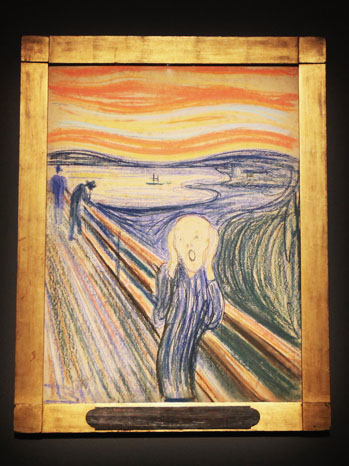 Originally published in the Marina Times San Francisco in June 2012
Originally published in the Marina Times San Francisco in June 2012
Edvard Munch’s “The Scream” sold at Sotheby’s on May 2 for 120 million dollars, the highest amount received for any auctioned piece in the history of art. Early estimates predicted that this 1895 artwork, a pastel and one of four versions, would sell for approximately 80 million. One version of “The Scream” resides at the National Museum and two at the Munch Museum, both in Oslo, Norway.
Born in 1863, Edvard Munch was one of the leaders of European Expressionism. His iconic painting “The Scream”, with its image of a figure holding his head, mouth-open on a bridge under a blood red sky, became a symbol of a world in which God and materialism had failed.
Twelve minutes after the auction began, a private buyer whose name was not released won the final bid. The irony of a work with an anti-materialist message selling for record prices was overshadowed by a concern about public versus private art. “The Scream” is the third high profile work in recent years to be auctioned for over 100 million dollars. As they increase in value, famous paintings have become out of reach for the average museum to acquire. In the future, will the great artworks of history no longer be available to be viewed by the public?
This is just the latest chapter in the dramatic life of Munch’s “Scream” paintings. In 1994, “The Scream” was stolen from the National Museum and later recovered. In 2004 the same version of “The Scream” was stolen for a second time, taken off the walls of the museum in broad daylight by armed and masked men. It was recovered again in 2006 ending a two-year odyssey during which the heist made world news. Copycat art crime became a recurring problem in Oslo. Public artworks were vandalized, even Edvard Munch’s tomb. The bust on his tomb was stolen, then returned with a painted face and wearing a tie.
When I was an undergraduate, I had an instructor who talked about theatre as a living art, and he used painting as an example of a dead art. “The art is hanging on the wall–it’s done! It’s over.” I can’t agree. Sotheby’s “Scream” auction once again proves that painting creates its own living drama, wrapped up in intrigue and notoriety, sometimes over a hundred years after the paint has dried.